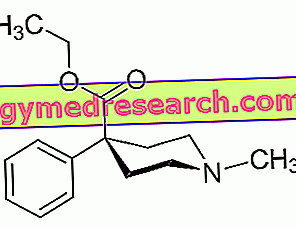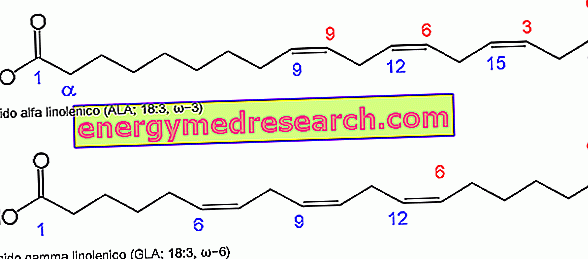Generality
Meperidine - also known as pethidine - is a drug belonging to the class of opioid analgesics.
It is a synthetic drug with an analgesic power equal to one tenth of that of morphine.

Meperidine - Chemical Structure
Meperidine has a rapid onset of action and a short duration of action and - unlike other opioid analgesics - can also be used in the obstetric field.
Since meperidine has poor oral bioavailability, parenteral administration is preferred.
Examples of medicinal specialties containing Meperidine (or pethidine)
- Petidina hydrochloride Molteni ®
- Petidina hydrochloride Monico ®
- Petidina hydrochloride SALF ®
Indications
For what it uses
Meperidine is indicated for the treatment of moderate to severe pain of different origins and nature, including post-operative pain, pain caused by neoplastic diseases and pain caused by labor (even in patients with preeclampsia and eclampsia).
Furthermore, meperidine can also be used in pre-anesthesia in adult patients.
Warnings
Due to the side effects that may occur, meperidine should be administered with caution in patients with chronic lung diseases, with obstructive gastrointestinal diseases, with chronic kidney diseases, with liver disease, with cardiovascular diseases and with organic brain diseases.
Following the use of meperidine - especially if carried out for long periods - tolerance and dependence can develop (both physical and mental). Therefore, meperidine should only be administered in patients who do not respond to other painkillers and only under the strict supervision of a doctor.
Meperidine is capable of altering the ability to drive vehicles and / or use machines, therefore, these activities should be avoided during treatment with the drug.
Finally, for those who carry out sporting activities, the use of meperidine without therapeutic necessity constitutes doping and in any case can determine positivity to doping tests even when taken for therapeutic purposes.
Interactions
Meperidine should not be given to patients who are taking - or have taken in the last two weeks - monoamine oxidase inhibitors (MAOIs) due to side effects that may occur.
Concomitant administration of meperidine and other drugs that can depress the central nervous system may increase the effects of meperidine itself. These drugs include:
- General anesthetics ;
- Hypnotic sedatives ;
- Anxiolytics ;
- Antipsychotics ;
- Tricyclic antidepressants ;
- Antihistamines .
Furthermore, alcohol also increases the effects of meperidine. Therefore, during treatment with the drug it is necessary to avoid alcohol consumption.
Concomitant administration of meperidine and barbiturates or cimetidine causes a reduction in the clearance of meperidine itself.
Phenothiazines, phenytoin (an antiepileptic) and tobacco, on the other hand, are capable of interfering with the hepatic metabolism of meperidine.
However, it is always good to inform your doctor if you are taking - or if you have recently been - drugs of any kind, including prescription-free medicines and herbal and homeopathic products.
Side effects
Meperidine can cause several types of side effects, although not all patients experience them. This is due to the different sensitivity of each individual towards the drug. Therefore, it is not said that all adverse effects occur with the same intensity in each person.
The following are the main side effects that may occur during meperidine therapy.
Nervous system disorders
During treatment with meperidine, the following may occur:
- Headache;
- Sedation;
- Tremors;
- Dizziness;
- Stiffening;
- Convulsions;
- Coma.
Psychiatric disorders
Meperidine therapy may cause:
- Euphoria or dysphoria;
- Hallucinations;
- Disorientation;
- Depression;
- Psychosis.
Cardiovascular disorders
Treatment with meperidine may promote the onset of:
- Hypotension or hypertension;
- vasodilation;
- Tachycardia;
- Syncope.
Endocrine disorders
Meperidine-based therapy may cause a decrease in the production of adrenocorticotropic hormone (or ACTH), glucocorticoids and thyroid stimulating hormone (or TSH) up to hypoadrenalism and hypothyroidism, respectively.
Other side effects
Other side effects that may occur during treatment with meperidine are:
- Dependence and tolerance;
- Spasm of the sphincter of Oddi;
- Nausea, vomiting and constipation;
- Dry mouth;
- Urinary retention;
- Erythema, rash, itching or hives;
- Urinary retention;
- Local irritation at the injection site;
- Allergic reactions in sensitive individuals.
Overdose
In case of excessive doses of meperidine, they can occur:
- Depression of the central nervous system up to the coma;
- Respiratory depression;
- Hypothermia;
- Cold and damp skin;
- Flabby muscle paralysis;
- bradycardia;
- Hypotension.
In severe cases, circulatory collapse, respiratory arrest, cardiac arrest and death may also occur.
The antidote in case of overdosage is naloxone, moreover, all the necessary support therapies must be established.
However, if a meperidine overdose is suspected, contact your doctor immediately and contact the nearest hospital.
Action mechanism
Meperidine is an μ opioid receptor agonist. These receptors are located along the pain pathways present in our body and their task is to modulate the neurotransmission of painful stimuli. More in detail, when these receptors are stimulated, analgesia is induced.
Meperidine - as an agonist of the aforementioned receptors - is able to activate them and therefore exert a pain-relieving action.
Mode of Use - Posology
Meperidine is available for subcutaneous, intramuscular or intravenous administration as a solution for injection.
Below are some indications on the doses of medication usually used in therapy.
Pain treatment
For the treatment of pain in adults, the dose of meperidine usually used is 25-100 mg, to be administered intramuscularly or subcutaneously. Alternatively, meperidine can be administered by slow intravenous infusion using a dose of 25-50 mg of drug.
In children, however, the dose of meperidine is administered intramuscularly at a dose of 0.5-2 mg / kg of body weight.
For the treatment of pain during labor, the dose of meperidine usually used is 50-100 mg, to be administered intramuscularly or subcutaneously as soon as the contractions occur at regular intervals.
Preanesthesia in adults
For adult pre-anesthesia, the dose of meperidine usually used is 50-100 mg, to be taken one hour before surgery.
Pregnancy and breastfeeding
Meperidine crosses the placenta and reaches the fetus, therefore, its use is contraindicated in pregnancy. The exception is the time of labor in which, instead, the drug can be used.
Because meperidine is excreted in breast milk and can cause respiratory depression in the newborn, its use is also contraindicated during breastfeeding.
Contraindications
The use of meperidine is contraindicated in the following cases:
- In patients with known hypersensitivity to the same meperidine;
- In patients with respiratory depression;
- In patients with intracranial hypertension;
- In patients suffering from acute bronchial asthma;
- In patients with pheochromocytoma;
- In patients with supraventricular tachycardia;
- In patients who are taking - or have recently taken - MAOIs;
- In patients suffering from seizure disorders;
- In patients with acute alcoholism or delirium tremens;
- In patients suffering from diabetic acidosis and at risk of coma;
- In patients with severe liver and / or kidney disorders;
- In patients with pre-existing central nervous system depression, especially if induced by drugs;
- In patients with hypothyroidism;
- In patients suffering from acute abdomen and paralytic ileus;
- In patients with Addison's disease;
- In pregnancy (with the exception of the time of labor);
- During breastfeeding.



